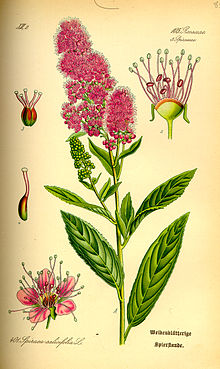Loading AI tools
Genus of plants From Wikipedia, the free encyclopedia
Spiraea /spaɪˈriːə/,[1] sometimes spelled spirea in common names, and commonly known as meadowsweets or steeplebushes, is a genus of about 80 to 100 species[2] of shrubs in the family Rosaceae. They are native to the temperate Northern Hemisphere, with the greatest diversity in eastern Asia.
| Spiraea | |
|---|---|
 | |
| Spiraea salicifolia | |
| Scientific classification | |
| Kingdom: | Plantae |
| Clade: | Tracheophytes |
| Clade: | Angiosperms |
| Clade: | Eudicots |
| Clade: | Rosids |
| Order: | Rosales |
| Family: | Rosaceae |
| Subfamily: | Amygdaloideae |
| Tribe: | Spiraeeae |
| Genus: | Spiraea L. |
| Species | |
|
About 80-100, see text | |
The genus formerly included the herbaceous species now segregated into the genera Filipendula and Aruncus; recent genetic evidence has shown that Filipendula is only distantly related to Spiraea, belonging in the subfamily Rosoideae.




Spiraea plants are hardy, deciduous-leaved shrubs. The leaves are simple and usually short stalked, and are arranged in a spiralling, alternate fashion. In most species, the leaves are lanceolate (narrowly oval) and about 2.5 to 10 centimetres (0.98 to 3.94 in) long. The leaf margins are usually toothed, occasionally cut or lobed, and rarely smooth. Stipules are absent.
The many small flowers of Spiraea shrubs are clustered together in inflorescences, usually in dense panicles, umbrella-like corymbs, or grape-like clusters. The radial symmetry of each flower is fivefold, with the flowers usually bisexual, rarely unisexual. The flowers have five sepals and five white, pink, or reddish petals that are usually longer than the sepals. Each flower has many (15 to 60) stamens. The fruit is an aggregate of follicles.[2]
Spiraea species are used as food plants by the larvae of many Lepidoptera species, including the brown-tail, the small emperor moth, the grey dagger, the setaceous Hebrew character, and the moth Hypercompe indecisa.
The leaves of S. betulifolia are eaten by blue grouse in spring, and the plant is browsed by deer in summer.[3]
Native Americans ate the species S. betulifolia.[4]

Many species of Spiraea are used as ornamental plants in temperate climates, particularly for their showy clusters of dense flowers. Some species bloom in the spring, others in midsummer.
The following species, hybrids and cultivars are among those found in cultivation:
Spiraea 'Arguta' (bridal wreath)[6] and Spiraea × cinerea 'Grefsheim'[7] have won the Royal Horticultural Society's Award of Garden Merit.
Spiraea contain salicylates. Acetylsalicylic acid was first isolated from Filipendula ulmaria,[citation needed] a species at the time classified in the genus Spiraea. The word "aspirin" was coined by adding a- (for acetylation) to spirin, from the German Spirsäure, a reference to Spiraea.[8][9][10]
Native American groups have various medicinal uses for local Spiraea species. S. betulifolia is used for abdominal pain and made into a tea.[11] The Blackfoot use S. splendens root in an enema and to treat venereal conditions.[12]
Native Americans found S. douglasii useful for making brooms and hanging seafood to cook.[13]

There are also numerous named hybrids, some occurring naturally in the wild, others bred in gardens, including several important ornamental plants:
Seamless Wikipedia browsing. On steroids.
Every time you click a link to Wikipedia, Wiktionary or Wikiquote in your browser's search results, it will show the modern Wikiwand interface.
Wikiwand extension is a five stars, simple, with minimum permission required to keep your browsing private, safe and transparent.